|
Start - Welkom
- Geschiedenis
- Literatuur - Familielegenden - Stamboom - Internetverbindingen - Alleen leden - Inhoud (sitemap)
|
|
|
||
| Boeken | ||

|
Over die familie Sillem | |
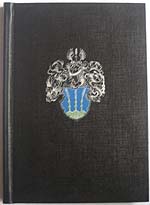 |
H. Carl Wilhelm Sillem & Hans-Wolff
Sillem (2002). Genealogie der Familie Sillem in
Deutschland. Uitgave in eigen beheer. martin@sillem.de Hierin vindt men alle in Duitsland vastgelegde Sillems vanaf de 16e eeuw tot nu toe. Evenals de "Chronik" ook rijk voorzien van afbeeldingen. De eerste Sillem genealogie werd in 1913 samengesteld door prof.dr. H.Carl Wilhelm Sillem. H.W Sillem zette het werk voort tot het jaar 2002. |
|
|
|
||
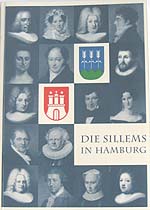 |
Hans-Wolff
Sillem (2005). Die Sillems in Hamburg. Uitgave in eigen beheer. martin@sillem.de Deze Kroniek beschrijft de geschiedenis van een van de oudste "raadsfamilies" van Hamburg, waarvan nog steeds nakomelingen bestaan. Rijk voorzien van afbeeldingen, De Sillems bezaten als z.g." Erbgesessene" het privilege om een lid van de familie af te vaardigen naar het stadsparlement. Dit voorrecht werd in 1860 ingetrokken bij de democratisering van het stadsbestuur. Daarmee verdween de naam Sillem van het politieke toneel van de Hansestad en is dat ook het einde van de Kroniek. Tot de 19e eeuw leefden de meeste Sillems in Hamburg. Daarna trokken verschillende familieleden naar het buitenland en stichtten daar nieuwe families. Zo vertakt de familie zich naar vele landen in de wereld. Sinds 2007 hebben nu wereldwijd levende Sillems via www.sillem-family.com de gelegenheid om met hun familiegeschiedenis bekend te raken en om eigen familiebijdragen toe te voegen. |
|
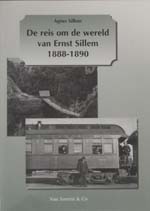 |
Agnes Sillem (1997). De reis om de wereld van Ernst Sillem 1888-1890. Verlag van Soeren & Co, Amsterdam Agnes Sillem is a granddaughter of Ernst Sillem (1864-1919) who spent his life in Amsterdam and was a partner in the bank of Hope & Co.
The history of this once so successful bank is closely connected to the
Sillem family. Before Ernst joint his father in the banking profession
he set out on a trip around the world, combining business and
adventure. On his way he visited numerous friends and customers of Hope
& Co. Ernst cruised through the United Staates and Canda, visited
many cities in Japan and China including Hong Kong, and travelled for
six months in Dutch India (nowadays Indonesia). On his way back he
travelled in India and made the passage through the Suez Canal. Ernst
travelled for a year and a half, on steamships, on trains and on
horseback. He left a travel diary which his granddaughter came across
more than a hundred years later. She turned it into a book and
published it in 1997.
|
|
 |
About various topics | |
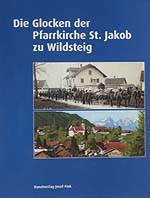 |
Jürgen Sillem (Herausgeber) (2006). Die Glocken der Pfarrkirche St. Jakob zu Wildsteig. Kunstverlag Josef Fink, Lindenberg. Jürgen Sillem tells the exciting story of the departure and return of three
bells during WW II that had been a property of St. Jacob's church in
Wildsteig, a village situated between Munich and Füssen. The
Nazi Reich
government had confiscated about 100.000 bells pretending to
recast the melted bronze to produce cannons, tanks and other military
equipment. In fact, at that time only steel was used to fabricate this
kind of weapons. The Wildsteig bells were transported by rail to
Hamburg harbour and stored there. While about 70.000 of all the bells were
melted down the three Wildsteig bells survived the time in exile
on the Hamburg "bell cemetery". To the absolute delight of the
Wildsteig people they arrived at home after a journey on river boats
after the end of the terrible war.
The book
„Die Glocken der
Pfarrkirche St. Jakob zu Wildsteig“ (The bells of the parish
church of Wildsteig) is available through book sellers. It can also be
ordered from the publisher „Kunstverlag Josef Fink“ in Lindenberg/Allg. (ISBN-No: 3-89870-323-1).
|
|
| |
||
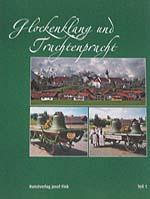 |
Jürgen Sillem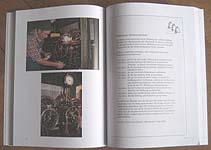 Two copiously illustrated books from the Bavarian place Wildsteig The Wildsteig people are an industrious bunch. They like to work (and work well) and they like to party. What's now the meaning of the Wildsteig Way of Partying? And why are the Wildsteig fests so pleasant? The answer, given by an honorary member of the Wildsteig Traditional Costumes Association: „Mei, wenn alles zammhilft, no loft’s oh“. Which is Bavarian and means something like "If everything fits, things will fall into place". And how come that everything fits? Careful handling of traditions, love of the place they call home, open-minded citizenship, development of a pronounced "we-feeling". All those virtues are gloriously evident from the pages of the two Wildsteig volumes. It is quite a pleasure to enter this Bavarian world, and the author has to be thanked for sharing his inner connectedness - although he is actually from the Palatinate region. |
|
| click on pictures to enlarge |
 |
  |